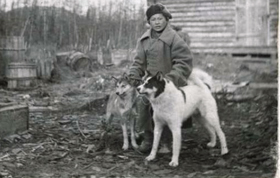The Russians and the Finns
Before there were breed standards or the name Karelian Bear Dog, museums and archives of Russian cynology (the study of canine evolution and breed development) provide documentary evidence of dogs that descended from the ancient spitz-type hunting dogs and looked identical to today's Karelian Bear Dogs (KBDs). Indeed, centuries ago, before stud books and dog registries and before political divisions of the native Karelian peoples, the gene pool of the spitz-type hunting dogs exhibited much genetic diversity, yet the isolation of roadless countrysides helped to preserve the local people's aboriginal dogs. Below, a photograph taken near the Vivi river in Siberia (N. P. Naumov, 1927) shows dogs with physical characteristics similar to those of today's KBD.

In appearance, the Karelian Bear Dogs exhibit traits of the native dogs of Finland, Karelia and the northeastern part of European Russia. However, even in this part of the world, native dogs became increasingly mixed with imported cultured breeds--such as Setters, Spaniels, hounds and later German Shepherds. It became clear that the only way to save the unique hunting qualities and natural beauty of the regional aboriginal dogs was for man to intervene with nature, selectively breeding local dogs for the genetic traits (such as size, shape and temperament) that most closely characterized the native dogs.
The breed standard written to describe the desireable traits for the Karelian Bear Dog differed in Finland and Russia. As a result, just as the Karelian people experienced political separateness, dogs that once shared overlapping gene pools began to diverge as distinct breeds.
The Finns began selectively breeding only black-and-white aboriginal dogs primarily from Komi. By 1936, the Finnish standard called for a black dog with white markings on the head, chest, legs and abdomen, and in 1946, the Karelian Bear Dog breed became recognized by Scandinavian and Finnish kennel clubs. Today, the Karelian Bear Dog is among the top ten most common dog breeds in Finland.
The Russians began breeding many of the same aboriginal dogs from Komi (in addition to those from the Archangelsk Province and other regions) during approximately the same time as did the Finns, but the Russians began by breeding all the original colors of the dogs: wolf gray of various shades, red coats like the standard spitz, and even black and tan. After World War II the Russians, too, began selectively choosing black-and-white dogs for breeding and named their breed the Russo-European Laika (REL).
Only recently were Karelian Bear Dogs imported to the United States and Canada. Most of the Karelian Bear Dogs bred in the United States are descendents from the KBDs and RELs that were brought to this country around 1991 by Dr. Shushanov. Names of his dogs can be found in pedigrees of many lines of KBDs now living in the United States. The Karelian Bear Dog was recognized by the Universal Kennel Club in 1996, and offspring from Dr. Shushanov's breedings were registered with the United Kennel Club as KBDs.
A super bear dog?
A false statement repeated by some who have written about the Karelian Bear Dog is that the Russians bred their dogs with the Utchak Sheepdog to create a "super bear dog" that exhibited even greater courage and stamina. Some sources offer descriptions of the physical and temperament traits of a large and ferocious Utchak "breed."
However, the Utchak has never been proven to exist in Russia. Russo-European Laikas originated from aboriginal dogs of the northeast part of European Russia, and they are not believed to have been cross bred with any other imported breed. In fact, the very existence of a so-called Utchak Sheepdog is yet to be proven. |